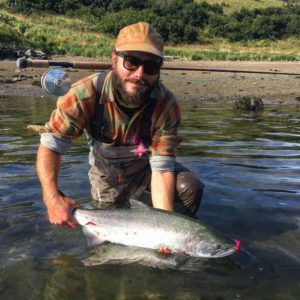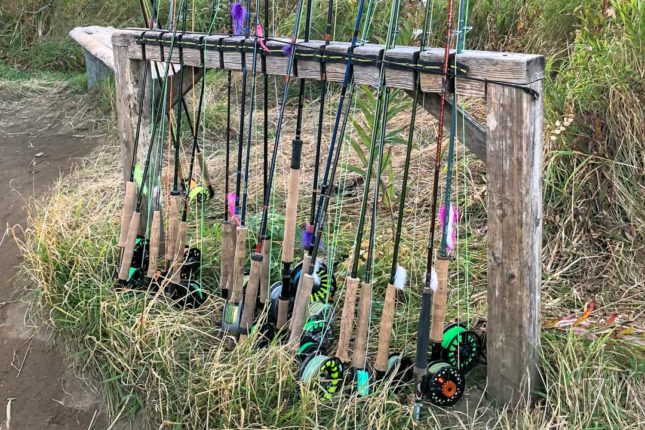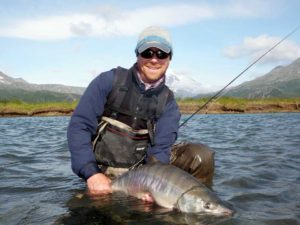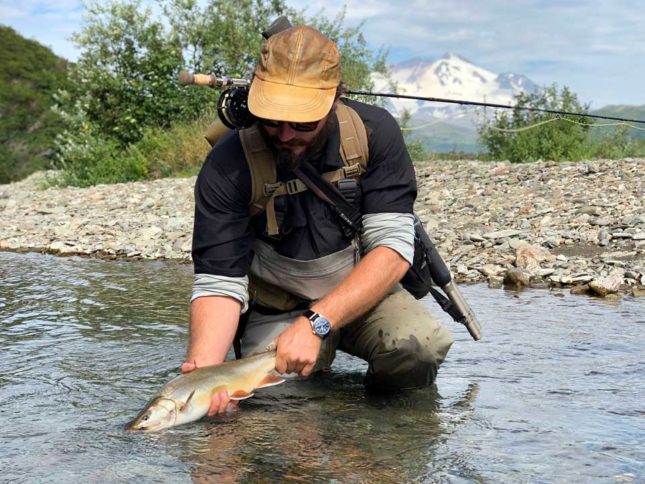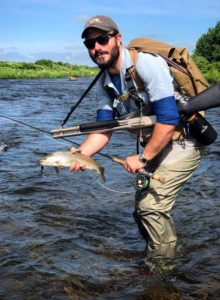Epic Blog
Machete’s Guide Gear Talk – Spey Fishing, Finale
10.19.20
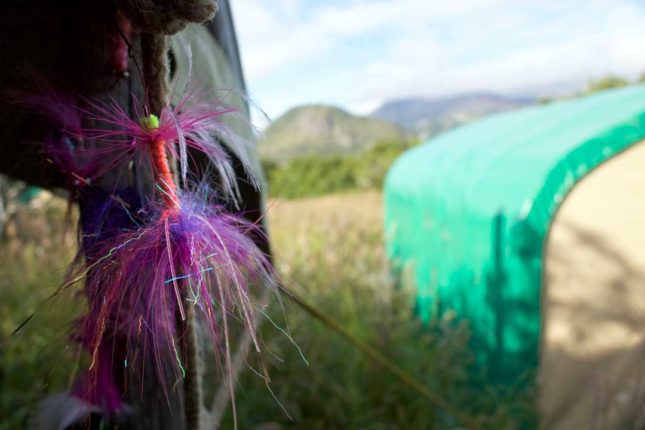
Skagit lines are designed to throw large, heavy flies to salmon in Alaska. But now micro spey lines offer new options for traditional single-hand 9′ fly rods.
Welcome back to the final installment of our ongoing discussion on spey rod applications for our SAFARI camp. In part 2 we fleshed out some of the major disadvantages for using a conventional two-handed rod set up for the waters we fish on the rugged Pacific coast of the Alaska Peninsula.
During this discussion we will shed some light on a few of the new developments within the world of spey lines. We will also discuss the reasons why they should be considered for anyone interested in utilizing spey tactics while spending a week with us at our SAFARI camp.
Line options
Before we dive into specifics, let’s quickly try to establish a basic knowledge for the two different types of spey lines that are most commonly used on modern spey rods.
Remember that we already discussed the basic characteristics of the line system in the prior article. It’s important to understand that these two lines both fall into the category of being shooting heads. The first head is what is called a Scandi, short for Scandinavian. The second is called a Skagit, named for the river of the same name in Washington state.
Scandi dandy
Without going into too much detail know this; a Scandi head is meant to deliver a light payload. Think unweighted fly, lighter tips. It has a more gradual taper and is in general longer in length when compared to a Skagit head. It is also possible to tie a leader directly to the end of a Scandi line in the same way you would tie a leader directly to the end of a conventional weight forward fly line.
Skagit magic
A Skagit (pronounced with a soft G) is meant to deliver a heavy payload. Think of a weighted fly with a heavier sinking tip running off the end of the line to the leader. It is in general shorter in length when compared to a Scandi and has a thicker, more aggressive taper. You cannot tie a leader directly to a Skagit head. You need to run some kind of tip between the head and your leader for optimal casting performance.
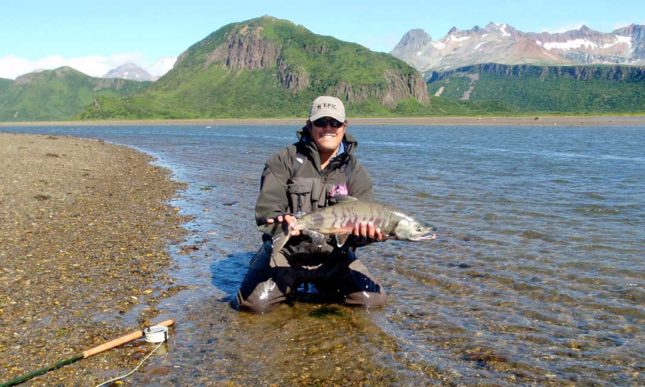
A two-handed rod with a Skagit head works pretty good, but the newer micro spey lines may be more adaptable to a wider range of conditions.
Liner notes
Both of these lines in their conventional form come as separate heads, meaning that you would need a reel with a running line attached that has a loop on the end. This would allow you to switch out between the different heads. Both of these types of heads come in many different varieties depending on the manufacturer. They are the predominant choice for anyone using a modern spey set up.
So you may be asking yourself, well, which is best for the water conditions at SAFARI camp? The answer is neither, at least not in the form that we’ve outlined above.
A Revolution
There has been a progression within the world of two-handed rods and lines for ever increasing compactness. Rod lengths have grown shorter, and as they have done so, the lines have followed. The most recent iteration of this has been the departure of these rod and line systems being linked exclusively to the world of steelhead and salmon.
Within the past 5 to 6 years there has been a revolution in spey line innovation for the angler who wants to use the advantages of spey casting to target smaller species of fish like rainbow trout or bass. This has provided the fly fishing community with an entirely new way of thinking about what is possible with any rod equipped with one of these newer lines. The biggest leap has been the emergence of lines that are tailored for use on a single-hand rod.
Breakdown
As we have discussed prior, there are some major disadvantages to consider for the prospective angler looking to bring their traditional two-handed rod to SAFARI camp.
Now let’s spotlight what some of the advantages are for anyone wanting to break with tradition and dive into the world of single-hand spey, or micro spey. We will also go into greater detail on what grain weights and types of lines to consider for the rods we most commonly use at our camp.
Perks of the job
First let’s discuss some of the major advantages for using these lines compared to a conventional weight forward fly line. The single biggest one is you eliminate the need for a backcast. No more finicky branches or snaggy banks to hamper your fishing. Remember that we do not throw the line into the air to load the rod with a spey cast. The line stays anchored in the water, like a roll cast. You still need room behind you to some degree, but the space requirements pale in comparison to what is needed for a conventional backcast.
A secondary major advantage is eliminating casting fatigue. If you’ve ever fished with us before, you know sore shoulder syndrome all too well. Overhead casting a heavy streamer all day with a single-hand rod can be brutal. Most of this is from the constant false casting required to achieve rod load and gain casting distance. Switching over to a spey cast eliminates the need to false cast all together. When done efficiently the rod should be doing most of the work for you.
Another advantage is you now have more control over where you want to fish your fly in the water column. Not all, but most of the lines we are going to discuss are intended to be fished with some kind of interchangeable tip at the end. This gives you the ability to adjust your sink ratio without over loading the rod with an extremely heavy fly.
That loving feeling
The last advantage is it’s just good old fashioned fun. I would especially recommend these lines to the seasoned fly fishing angler. Considering that many of these lines are intended for use on a single-hand rod, you probably already have everything you need minus the line and a few tips. Anyone well versed in the conventional practices of single-hand casting can have a ball out on the water with something new and exciting. Ultimately, spey casting can open up an entire universe of otherwise unknown possibilities and pleasures.
Talking shop
Okay, so now let’s talk specifics when it comes to both lines and rods for anyone whose curiosity has been piqued by this ongoing discussion. One thing to bear in mind is that SAFARI camp offers two unique fishing venues. One for Dolly Varden and another for salmon. I will try to cover tackle recommendations for both.
Making the right line choice
Selecting the right line is one of the single most important things to get right for any type of fly fishing pursuit. You want something that is matched to the weight of your rod while also considering how the design of the line will cater itself to the fishing venue.
In my mind the single most important quality for anyone looking at a micro spey or single-hand spey line for SAFARI camp is that the line is integrated. Remember that most conventional spey heads are just that, a head. The running line is separate. This creates a junction where the two lines are looped together. This is not ideal for the kind of fishing we do most often.
Integration gratification
The advantage of having an integrated line is there is now a smooth transition between the running line and the head. In other words, there is no loop to loop connection. The running line and the head are one. This is ideal for our waters because we are often stripping flies. An integrated line will allow for a seamless transition during your strip as you bring the head within the guides of your rod.
Integrated line considerations for Salmon
Let’s discuss a few options for these types of lines for someone looking to rig up their salmon rod.
My first choice would be a Commando Smooth from OPST. These are Skagit heads, so bear in mind that they’re specifically meant for turning over medium to larger flies with some kind of sink tip attached to the end of the line. You also have the option of connecting a floating tip if you only want the weight of the fly to achieve depth or if you want to fish a topwater pattern. These lines come in a range of grain weights. Now, this can be confusing for most folks. You need to figure out what grain weight corresponds to the weight of your rod.
Basically, the higher the grain weight the heavier the line is. So for a typical salmon rod at our camp, let’s say a 9′ rod between the 7 to 8 wt range, you would want something in the 250 – 300 grain weight window. I think a 275 – 300 would be in the money for a stout 8 wt while a 250 – 275 would be butter on a 7 wt.
Another option is Rio’s InTouch Skagit trout spey. They’ve gone through the trouble of designating what grain weight corresponds to a single-hand rod. Although they’re designations seem to run higher than OPST’s for the same weight rod, it is still in the general ballpark. For example their 4 wt is 325 grains which would match up with a 7 – 8 wt single hand rod.
Integrated line considerations for Dolly Varden
Again one of my first choices would be a Commando Smooth from OPST if I wanted a Skagit style head. Now we need to grain down in weight because we are talking about a lighter rod. Let’s consider a 5 – 6wt rod in the 9′ range. Something in the 200 – 225 grain weight window would be in the money.
For this lighter category of rods Rio offers another very interesting contender.
Their InTouch trout spey is a departure from the more aggressive taper of a Skagit head while still offering the convenience of being a fully integrated line. The take away is while this line will still be able to cast smaller streamers, it will not be able to handle the heavy payload that a Skagit head could. For this reason I would not recommend it for a heavier salmon rod at our camp, but I think it would be magical on the upper stretches of our small coastal river for the angler focused on hunting for dollies.
Again let’s consider a typical Dolly Varden setup at our camp, something in the 5 – 6 wt range for a 9′ rod. Their 2 wt pairs up with a 9′ 5 wt weighing in at 230 grains, while their 3 wt pairs with a 9′ 6 wt coming in at 265 grains.
Another series of lines to take note of comes from Scientific Anglers. They have recently come out with their Spey Lite series which includes both an integrated Skagit and integrated Scandi head. Both lines are offered in a wide range of grain weights lending themselves to either a light dolly setup or a heavier salmon rig.
One last word on integrated spey line considerations should include the mention of Royal Wulff’s Ambush triangle taper series of lines. They would fall into the Skagit head category and come in a generous array of grain weights.
Micro speys
Now that we’ve covered some of the different lines to pair with a standard single-hand rod let’s wade into the world of micro spey rods. Again, like the lines themselves, this is the frontier of spey innovation in the world of fly fishing. For the purposes of this discussion and the water we are considering at our SAFARI camp, most of these rods will be best suited for Dolly Varden.
Under eleven
The truth of the matter is it’s hard to find a two-handed rod that is under 11′ in length. We would generally consider them to be switch rods, or micro spey’s. Lately there has been an explosion of rods designated as trout spey’s, but they typically run in the 11′ plus range. I have to admit that a 12′ 3 wt sounds awesome, but it would simply be too long for the water we fish at our camps on the Alaska Peninsula.
For me, finding something in the sub 11′ range to use for rainbow trout and Dolly Varden while spending my summers up north became a kind of holy grail.
Deliverance
It came in the form of a 10′ 5 wt switch rod from Beulah. The first time I picked up this miniature spey rod at a speyclave outside of Portland, OR I knew I had finally found what I had been looking for. This rod, with its compact length, can be wielded as both a true spey or as a single-hand spey. It fit the bill perfectly for both the Bristol Bay camp and the excellent Dolly Varden fishing to be found on the Pacific coast.
Last season I paired it up with a 230 grain Rio Scandi body. It balanced the rod well but its one serious drawback was that the line was a Scandi head, not a fully integrated line. I therefore ran into the issues that we’ve already discussed when fishing with a conventional shooting head.
If I had been able to return to camp this season I would have opted for either Scientific Anglers Spey Lite Integrated Scandi or Rio’s Intouch trout spey to negate the pitfalls of having to deal with a loop to loop junction. Lucky for me both Rio and SA offer a line in a similiar grain window to the 230 grain head I have been using, although I think graining up to a 265 or 270 would have been worth considering to get a deeper load out of the rod.
More rods than you can shake a stick at
Let’s consider a few more options.
Again, for anyone interested in not only enjoying the benefits of a spey line but also pairing it with a two handed rod Beulah’s 10′ 5 wt platinum switch rod is a fine choice for either camp. They also make a 10’ 4″ 6 wt that would be an interesting crossover rod for both Dolly Varden and salmon at SAFARI camp.
OPST’s micro skagit offerings in both the 10′ 4 wt and 10’ 4″ 5 wt are worthy of consideration as either a trout or Dolly Varden stick for either operation. They also make a 10’ 8″ 6 wt that would be an interesting choice for a crossover salmon rod at our SAFARI camp.
A few years ago Jerry French teamed up with Pieroway Rods to design a series of micro spey rods that should be on anyone’s radar looking to break into the single-hand/micro spey game. For trout at our first camp or Dolly Varden at either of our two camps his 9’ 6″ 5 wt should be a serious contender. There’s also a 10’ 6″ 6 wt that would be worth considering as a crossover salmon rod at our second camp.
Wrapping up
Well folks, I think that about covers it, and then some, as far as spey considerations are concerened for SAFARI camp. If you’re wondering about whether or not some of the spey line considerations we discussed for a single-hand rod geared toward Dolly Varden could be applied to the rainbow trout we encounter at OUTPOST camp, the answer is absolutely.
Before signing off I would recommend anyone interested in learning more about what has been discussed in these articles to utilize the knowledge of their local fly shop if they are lucky enough to have one close by. If not, I always enjoy talking shop when it comes to all things spey. Email me at any time if you have specific questions about spey rod and line recommendations for either of our remote fly fishing trips in Alaska.
Cheers.
Find more Machete articles here.
Posted in All Posts, Fishing, Gear, OUTPOST, SAFARI

